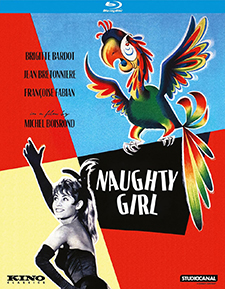Naughty Girl (Blu-ray Review)

Director
Michel BoisrondRelease Date(s)
1956 (September 3, 2024)Studio(s)
Lutetia/SLPF/Selb-Film/Sonodis (Kino Classics)- Film/Program Grade: B+
- Video Grade: A-
- Audio Grade: A
- Extras Grade: B-
Review
I last saw the French-made Brigitte Bardot comedy Naughty Girl (1956) when it was released on DVD nearly a quarter-century ago, I think by Image Entertainment. At that time, in the United States, it was something of a novelty to be able to watch a French film that wasn’t a classic by Renoir or Godard or the work of some other French master. “Pure entertainment,” the picture was a real charmer back in those days. Since then, on both DVD and Blu-ray, there has been an explosive influx of French genre films of all kinds, diminishing Naughty Girl’s novelty some, though Kino’s new Blu-ray is undeniably a major upgrade. Imitative of big Hollywood studio pictures, Naughty Girl may have the cinematic nutritional value of marzipan, but in more ways than one offers plenty of eye-candy.
The Mississippi cabaret, owned by Paul Latour (Bernard Lancret) is being used as a front for criminals passing counterfeit U.S. dollars. Framed for the crime, Latour flees to Switzerland hoping to expose the real perpetrators. Concerned that his daughter, Brigitte (Bardot), who believes her father to be a shipbuilder, might be implicated, Latour arranges to have his star attraction, handsome singer Jean Clery (Jean Bretonnière), collect Brigitte from finishing school and look after her. Jean, incidentally, is introduced in a musical number where he resembles Ricky Ricardo singing at the Tropicana.
At every turn Brigitte causes trouble, including almost burning down Jean’s home. Despite this, and despite Jean being engaged to psychiatrist Lili (Françoise Fabian), he and Brigitte soon fall in love.
This quasi-musical comedy is a Hollywood-influenced confection, complete with Arthur Freed-MGM-style musical dream sequences straight out of An American in Paris. French-born but mostly Hollywood-based cinematographer Joseph C. Brun shot the film in candy-colored CinemaScope. Brun’s credits include everything from The Joe Louis Story to Odds Against Tomorrow and several Cinerama/Cinemiracle titles, as well as Howard Hawks’ Hatari! He uses the CinemaScope screen shape inventively. In a couple of scenes he creates split-screen images predating their use in the Doris Day-Rock Hudson films, but without an optical printer—the split images are all created on-set.
Director Boisrond had been an assistant director to René Clair, Henry King, Anatole Litvak, and even Orson Welles (on Mr. Arkadin), with Naughty Girl one of his first films as director. He and Brun infuse the bright, sunny film with a beguiling, if featherweight sense of fun.
Naughty Girl (Cette sacrée gamine—Mam’zelle Pigalle, or “That Damn Kid—Mam’zelle Pigalle”) was co-written by Roger Vadim (billed as “Vadim” in the credits), who later that same year solidified Bardot’s international screen goddess status with And God Created Woman, though Bardot had been in films since 1952 and even co-starred in the 1955 British comedy Doctor at Sea. Here, the comedy is a bit more adult, with fleeting nudity even (not Bardot), but also loads of broad slapstick, complete with Three Stooges-like sound effects and fast, dense dialogue, as if aspiring for the kind of verbal wit that one associates with writer-director-actor Sacha Guitry. Undoubtedly some of this verbal sparring doesn’t travel for non-French speakers, even those aided by English subtitles, such as much of the sardonic reactions of Jean’s butler, Jérôme, (Raymond Bussières). Other attempts at humor yield mild amusement, such as the fact that the police inspectors on the counterfeit laundering case are all foodies, obsessing over dishes at nearby cafés rather than focusing their attentions on the case. Mischa Auer, Russian-born character star of innumerable ‘30s screwball comedies in Hollywood, moved to France in the mid-1950s and continued working there. In Naughty Girl he turns up in a rather embarrassing extended cameo as ballet master Igor, joining a chase in which he repeatedly bonks his head.
Kino Lorber’s Blu-ray of Naughty Girl, licensed from StudioCanal, dramatically improves upon the long-ago DVD. In 2.39:1 widescreen, the 1920x1080p image is impressively sharp for early CinemaScope, lacking the “CinemaScope mumps” distortions of those 1953-55 era releases. The bright use of primary colors also “pop” with only dissolves and other optical effects dampening the presentation. The DTS-HD Master Audio 2.0 mono is likewise impressive, in French only supported by optional English subtitles, the only letdown being that the song lyrics go unsubtitled. Region “A” encoded.
Aside from a trailer for the later Bardot vehicle Les Femmes (1969), released simultaneously on Blu-ray by Kino, the only extra is an okay commentary track by Samm Deighan.
No cinematic masterpiece but ingratiating fun, Naughty Girl is recommended.
- Stuart Galbraith IV

